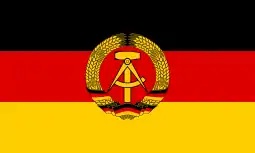Satellite state
A satellite state or dependent state is a country that is formally independent in the world but under heavy political, economic, and military influence or control from another country.[1] The term was coined by analogy to planetary objects orbiting a larger object, such as smaller moons revolving around larger planets, and is used mainly to refer to Central and Eastern European countries of the Warsaw Pact during the Cold War,[2] as well as to Mongolia and Tuva between 1924 and 1990,[3] all of which were economically, culturally, and politically dominated by the Soviet Union. While primarily referring to the Soviet-controlled states in the Central and Eastern Europe or Asia, in some contexts the term also refers to other countries under the Soviet hegemony during the Cold War, such as North Korea (especially in the years surrounding the Korean War of 1950–1953), Cuba (particularly after it joined the Comecon in 1972), and some countries in the American sphere of influence, such as South Vietnam (particularly during the Vietnam War). In Western usage, the term has seldom been applied to states other than those in the Soviet orbit. In Soviet usage, the term applied to the states in the orbit of Nazi Germany, Fascist Italy, and Imperial Japan, whereas in the West the term to refer to those has typically been client states.
| Part of the Politics series |
| Basic forms of government |
|---|
| List of forms of government |
|
|
The Oxford English Dictionary traces the phrase satellite state in English back as early as 1916. In times of war or political tension, satellite states sometimes served as buffers between an enemy country and the nation exerting control over the satellites.[4]
Soviet satellite states
Interwar period
When the Mongolian Revolution of 1921 broke out, Mongolian revolutionaries expelled Russian White Guards (during the Russian Civil War of 1917–1923 following the October Revolution of 1917) from Mongolia, with the assistance of the Russian Red Army. The revolution also officially ended Manchurian sovereignty over Mongolia, which had existed since 1691.[5] Although the theocratic Bogd Khanate of Mongolia still nominally continued, with successive series of violent struggles, Soviet influence got ever stronger. In 1924, after the Bogd Khaan died of laryngeal cancer[6] or, as some sources suggest, at the hands of Soviet spies,[7] the Mongolian People's Republic was proclaimed on November 26, 1924. A nominally independent and sovereign country, it has been described as being a satellite state of the Soviet Union in the years from 1924 until 1990. This is supported by the fact that the Mongolian PR collapsed less than two months after the dissolution of the Soviet Union.[3][8]
During the Russian Civil War, the Soviet Red Army troops occupied Tuva in January 1920, which had also been part of the Qing Empire of China and a protectorate of Imperial Russia. The Tuvan People's Republic was proclaimed a nominally independent state in 1921, although it was tightly controlled by Moscow and is considered a satellite state of the Soviet Union until 1944, when the USSR annexed it into the Russian SFSR.[8]
Another early Soviet satellite state in Asia was the short-lived Far East Republic in Siberia.[8]
Post-World War II
At the end of World War II, most eastern and central European countries were occupied by the Soviet Union,[9] and along with the Soviet Union made up what is called the Soviet Empire. The Soviet forces remained in these countries after the war's end.[10] Through a series of coalition governments including communist parties, and then a forced liquidation of coalition members disliked by the Soviets, Stalinist systems were established in each country.[10] Stalinists gained control of existing governments, police, press and radio outlets in these countries.[10] Soviet satellite states of the Cold War included:[10][11][12][13]
.svg.png.webp) People's Republic of Albania (1946–1961)
People's Republic of Albania (1946–1961).svg.png.webp) Polish People's Republic (1947–1989)
Polish People's Republic (1947–1989).svg.png.webp) People's Republic of Bulgaria (1946–1990)
People's Republic of Bulgaria (1946–1990).svg.png.webp) Romanian People's Republic (1947–1965)
Romanian People's Republic (1947–1965) Czechoslovak Socialist Republic (1948–1989)
Czechoslovak Socialist Republic (1948–1989) German Democratic Republic (1949–1990)
German Democratic Republic (1949–1990).svg.png.webp) Hungarian People's Republic (1949–1989)
Hungarian People's Republic (1949–1989).svg.png.webp) Federal People's Republic of Yugoslavia (1945–1948)
Federal People's Republic of Yugoslavia (1945–1948).svg.png.webp) Mongolian People's Republic (1925–1990)
Mongolian People's Republic (1925–1990)
The three Communist countries of Eastern Europe which managed to later shake off Soviet control were Albania, Romania and Yugoslavia.[14] The Federal People's Republic of Yugoslavia is considered an early Soviet satellite,[10][11] as it broke from Soviet orbit in the 1948 Tito–Stalin split, with the Cominform offices being moved from Belgrade to Bucharest, and Yugoslavia subsequently formed the Non-Aligned Movement. The People's Socialist Republic of Albania, under the leadership of Stalinist Enver Hoxha, broke ties with the Soviet Union in the Albanian–Soviet split following the Soviet de-Stalinization process.[15] In 1961, with Chinese support, Albania managed to completely wrestle itself from Soviet influence.[14] The last country to manage that was Romania, with its long de-satellization process which started in 1956 and ended by 1965.[16] Romania was fully aligned with the Soviet Union until the early 1960s, throughout its first 15 years as a Communist state. However, serious economic disagreements with Moscow resulted in a final rejection of the Soviet hegemony in 1964.[17]
The Soviet-installed Democratic Republic of Afghanistan can also be considered a satellite state; from 1978 until 1991, the central government in Kabul was aligned with the Eastern Bloc and was directly supported by the Soviet military between 1979 and 1989 against the people of the country in what is known as the Soviet–Afghan War. The short-lived East Turkestan Republic (1944–1949) was a Soviet satellite until it was absorbed into the People's Republic of China.
The Mongolian People's Republic was a Soviet satellite from 1924 to 1991. The Soviet Union so tightly controlled it that the country ceased to exist in February 1992, less than two months after the dissolution of the Soviet Union.[18]
Post-Cold War use of the term
Some commentators have expressed concern that United States military and diplomatic interventions in the Balkans and in the Middle East and elsewhere might lead, or perhaps have already led, to the existence of American satellite states.[19][20] William Pfaff has warned that a permanent American presence in Iraq would "turn Iraq into an American satellite state".[21] The term has also been used in the past to describe the relationship between Lebanon and Syria, as Syria has been accused of intervening in Lebanese political affairs.[22] In addition, Eswatini and Lesotho have both been described as satellite states of South Africa.[23] In Europe, Belarus has also been described as a satellite state of the Russian Federation.[24]
See also
Notes
- Betts, R. R. (January 1945). "The European Satellite States: Their War Contribution and Present Position". International Affairs. 21 (1): 15–29. doi:10.2307/3018989. JSTOR 3018989.
- "Source: NATO website 2nd Footnote at bottom". nato.int. Archived from the original on 16 August 2017. Retrieved 9 May 2018.
- Sik, Ko Swan (1990). Nationality and International Law in Asian Perspective. Martinus Nijhoff Publishers. p. 39. ISBN 978-0-7923-0876-8.
- Wood, Alan (2005) [1990]. Stalin and Stalinism. Routledge. p. 62. ISBN 978-0-415-30732-1. Retrieved 2009-09-10.
- "History of the U.S. and Mongolia". U.S. Embassy in Mongolia.
- Кузьмин, С.Л.; [Kuzmin, S.L.]; Оюунчимэг, Ж.; [Oyunchimeg, J.]. "Буддизм и революция в Монголии" [Buddhism and the revolution in Mongolia] (in Russian). Archived from the original on March 6, 2016.
- Догсомын Бодоо 1/2 on YouTube (Mongolian)
- Narangoa, Li; Cribb, Robert B (2003). Imperial Japan and National Identities in Asia: 1895–1945. Psychology Press. pp. 13, 66. ISBN 978-0-7007-1482-7.
- Wettig 2008, p. 69
- Rao 2006, p. 280
- Langley 2006, p. 30
- Merkl 2004, p. 53
- Rajagopal 2003, p. 75
- Schmid, Alex Peter (October 19, 1985). Social Defence and Soviet Military Power: An Inquiry Into the Relevance of an Alternative Defence Concept : Report. Center for the Study of Social Conflict (C.O.M.T.), State University of Leiden. ISBN 9789034607386 – via Google Books.
- Olsen 2000, p. 19
- Crampton, R. J. (July 15, 2014). The Balkans Since the Second World War. Routledge. ISBN 9781317891178 – via Google Books.
- Political Handbook of the World 1998. Springer. February 1, 2016. ISBN 9781349149513 – via Google Books.
- Sergey Radchenko (June 26, 2020). "Russia Still Treats Mongolia Like a Soviet Satellite". Foreign Policy.
- "Serbia Says U.S. Wants Kosovo To Be 'Satellite State'". Radio Free Europe/Radio Liberty. 15 August 2007.
- Bailes, Jon; Aksan, Cihan (28 November 2008). "On Israel: An Interview with Norman Finkelstein". State of Nature: an Online Journal of Radical Ideas. Archived from the original on 2010-11-28.
- Cooley, John (18 June 2008). "How to silence that Iran war drumbeat". The Christian Science Monitor.
- Wachter, Paul (January 26, 2002). "Who killed Elie Hobeika?". Salon. Archived from the original on May 23, 2010.
- Mehran Kamrava (2008). Understanding Comparative Politics: A Framework for Analysis. Routledge. p. 73. ISBN 978-0-415-77304-1.
- Silva, Chirani (1 November 2022). "Belarus: The Final Satellite State?". Project Patriarchy. Archived from the original on 8 November 2022.
References
- Langley, Andrew (2006), The Collapse of the Soviet Union: The End of an Empire, Compass Point Books, ISBN 0-7565-2009-6
- Merkl, Peter H. (2004), German Unification, Penn State Press, ISBN 0-271-02566-2
- Olsen, Neil (2000), Albania, Oxfam, ISBN 0-85598-432-5
- Rajagopal, Balakrishnan (2003), International law from below: development, social movements, and Third World resistance, Cambridge University Press, ISBN 0-521-01671-1
- Rao, B. V. (2006), History of Modern Europe Ad 1789–2002: A.D. 1789–2002, Sterling Publishers Pvt. Ltd, ISBN 1-932705-56-2
- Wettig, Gerhard (2008), Stalin and the Cold War in Europe, Rowman & Littlefield, ISBN 978-0-7425-5542-6
- Wood, Alan (2005), Stalin and Stalinism, Routledge, ISBN 978-0-415-30732-1